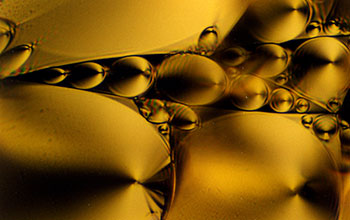Multimedia Gallery
Polarizing microscope texture of smectic A liquid crystal
Polarizing microscope texture of a smectic A liquid crystal.
More about this Image
In smectic A, rod-like elongated molecules are arranged parallel to each other, forming layers of monomolecular length. The layers are stacked on top of each other and are flexible. When the smectic layers bend, they tend to preserve their equidistance, as it is fixed by the molecular length. The restriction of constant layer thickness leads to a peculiar geometry of deformations, so-called focal conic domains, in which the smectic layers are wrapped around line defects in the form of ellipses (seen in the figure) and hyperbolae (most of them are oriented normally to the plane of fiew). The ellipses form a fractal-type of structure, with smaller ones filling the gaps between the larger ones. The smectic order was discovered and correctly identified from optical observations of textures similar to the one shown here, on the basis of geometrical properties of ellipses and hyperbolae, before X-ray techniques were invented. The graphic Polarization Microscope Image of Liquid Crystals (Image 12) illustrates how the smectic layers are arranged around the ellipses and hyperbolae--bent, but everywhere else equi-distant to each other.
This image was created by Oleg D. Lavrentovich, director of the Liquid Crystal Institute and professor of chemical physics in the Chemical Physics Interdisciplinary Program at Kent State University. The complex, 3-D molecular arrangements in liquid crystals and other soft materials reflect a rich variety of physical mechanisms that represent the focus of Lavrentovich's research.
Recent research in Lavrentovich's lab (supported by National Science Foundation grants DMR 05-04515, DMR 07-10544 and DMR 09-06751), explore what the physical mechanisms are behind the complex, 3-D molecular architectures; what controls the molecular order in space; and what controls the time dynamics of this order. The goal is to learn how to construct self-assembled complex materials with unique structural, electric and optical properties. Liquid crystals have already been a technological revolution through their liquid crystal displays, and much more is on the horizon of current knowledge if we were to explore and utilize more complex molecular arrangements than those in these displays. (Date of Image: exact date unknown)
Credit: Oleg Lavrentovich, Liquid Crystal Institute, Kent State University
See other images like this on your iPhone or iPad download NSF Science Zone on the Apple App Store.
Images and other media in the National Science Foundation Multimedia Gallery are available for use in print and electronic material by NSF employees, members of the media, university staff, teachers and the general public. All media in the gallery are intended for personal, educational and nonprofit/non-commercial use only.
Images credited to the National Science Foundation, a federal agency, are in the public domain. The images were created by employees of the United States Government as part of their official duties or prepared by contractors as "works for hire" for NSF. You may freely use NSF-credited images and, at your discretion, credit NSF with a "Courtesy: National Science Foundation" notation.
Additional information about general usage can be found in Conditions.
Also Available:
Download the high-resolution JPG version of the image. (2.4 MB)
Use your mouse to right-click (Mac users may need to Ctrl-click) the link above and choose the option that will save the file or target to your computer.

 All images in this series
All images in this series